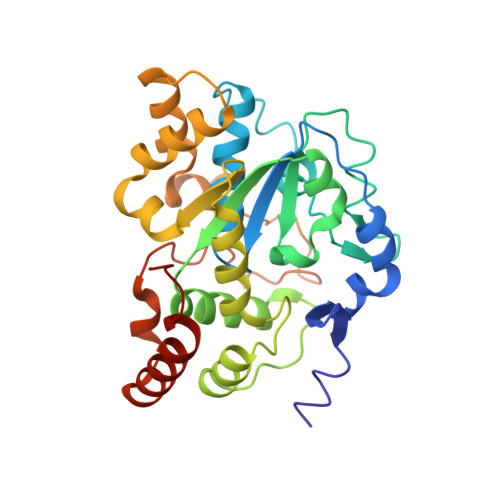Crystal structure of the human estrogen sulfotransferase-PAPS complex: evidence for catalytic role of Ser137 in the sulfuryl transfer reaction.
Pedersen, L.C., Petrotchenko, E., Shevtsov, S., Negishi, M.(2002) J Biological Chem 277: 17928-17932
- PubMed: 11884392
- DOI: https://doi.org/10.1074/jbc.M111651200
- Primary Citation of Related Structures:
1HY3 - PubMed Abstract:
Estrogen sulfotransferase (EST) transfers the sulfate group from 3'-phosphoadenosine 5'-phosphosulfate (PAPS) to estrogenic steroids. Here we report the crystal structure of human EST (hEST) in the context of the V269E mutant-PAPS complex, which is the first structure containing the active sulfate donor for any sulfotransferase. Superimposing this structure with the crystal structure of hEST in complex with the donor product 3'-phosphoadenosine 5'-phosphate (PAP) and the acceptor substrate 17beta-estradiol, the ternary structure with the PAPS and estradiol molecule, is modeled. These structures have now provided a more complete view of the S(N)2-like in-line displacement reaction catalyzed by sulfotransferases. In the PAPS-bound structure, the side chain nitrogen of the catalytic Lys(47) interacts with the side chain hydroxyl of Ser(137) and not with the bridging oxygen between the 5'-phosphate and sulfate groups of the PAPS molecule as is seen in the PAP-bound structures. This conformational change of the side chain nitrogen indicates that the interaction of Lys(47) with Ser(137) may regulate PAPS hydrolysis in the absences of an acceptor substrate. Supporting the structural data, the mutations of Ser(137) to cysteine and alanine decrease gradually k(cat) for PAPS hydrolysis and transfer activity. Thus, Ser(137) appears to play an important role in regulating the side chain interaction of Lys(47) with the bridging oxygen between the 5'-phosphate and the sulfate of PAPS.
- Pharmacogenetics Section, Laboratory of Reproductive and Developmental Toxicology, National Institute of Environmental Health Sciences, National Institutes of Health, Research Triangle Park, North Carolina 27709, USA.
Organizational Affiliation:

















